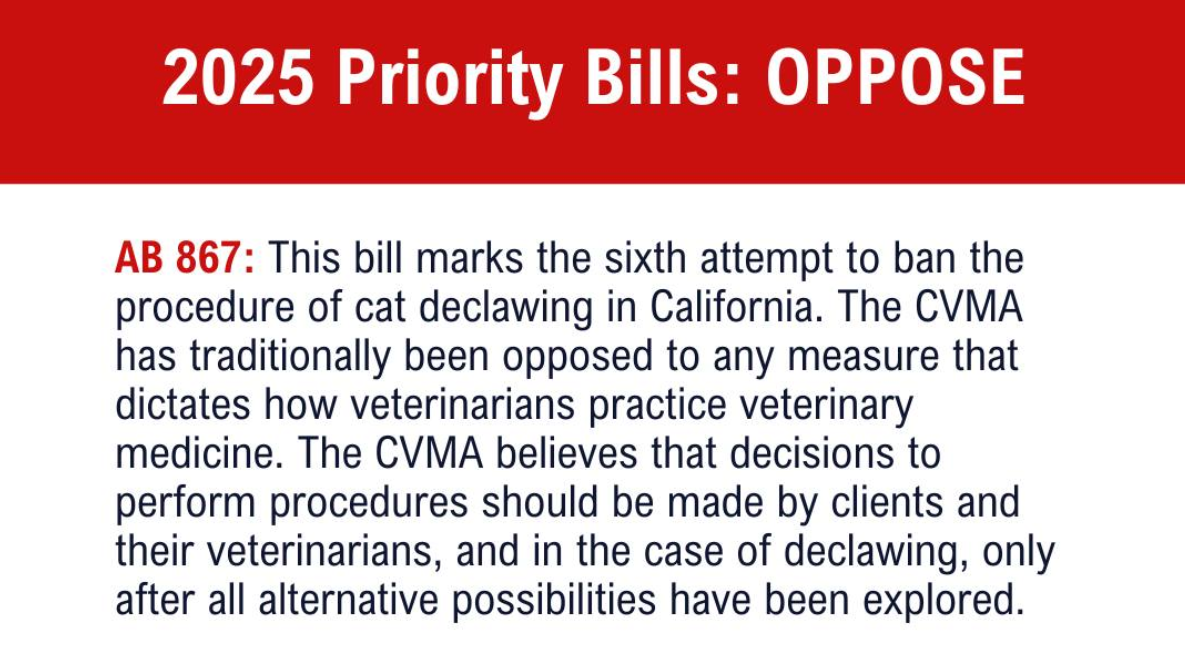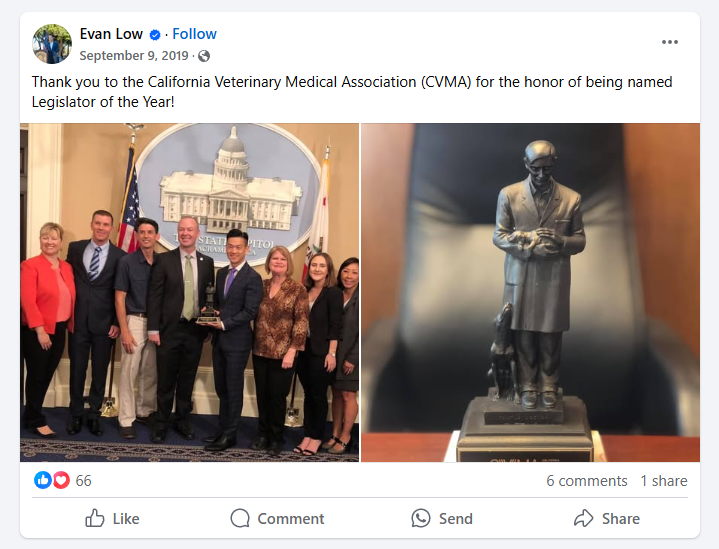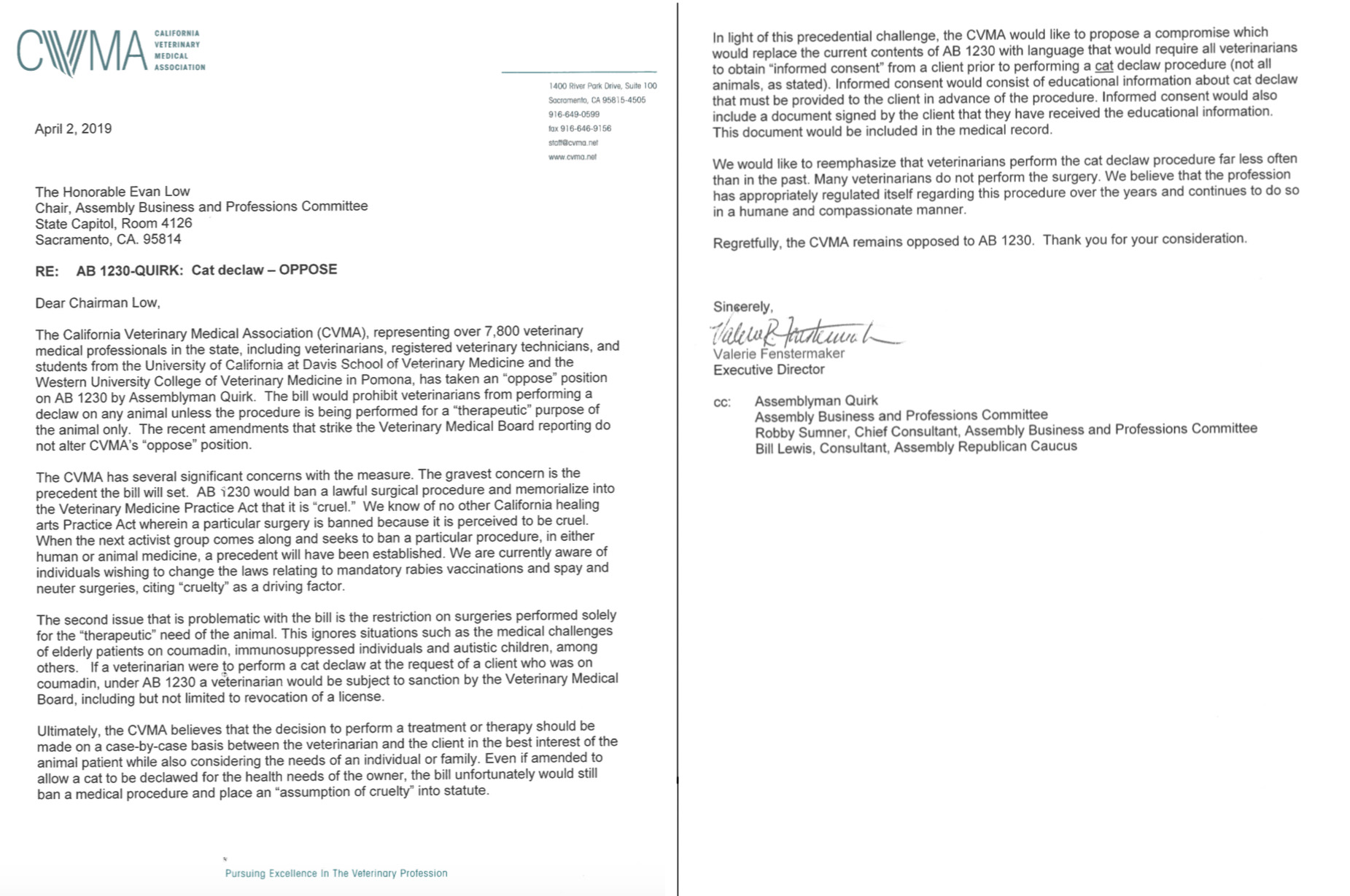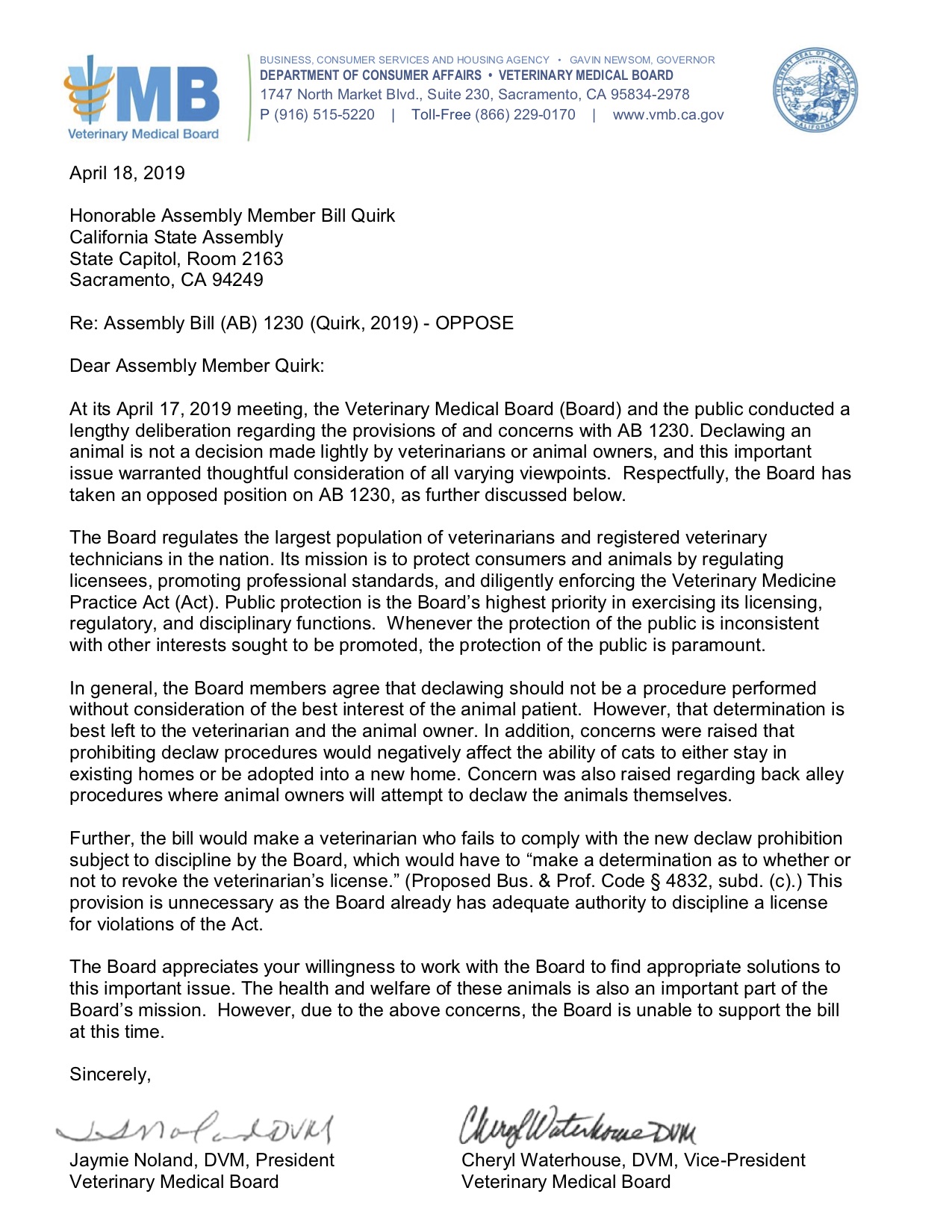Update. April 2025.
The California Veterinary Medical Association is once again trying to stop the 2025 anti-declawing bill in California. Here’s a photo of a post they did on their facebook page on March 26, 2025 and the caption read, “This past Saturday, the CVMA Board of Governors convened to take formal positions on 2025 California legislation. CVMA Legislative Committee Co-chairs Dr. Brent Wooden and Dr. Keith Rode presented each bill, along with a recommended position from the Legislative Committee. These are the CVMA’s priority bills for 2025. More information about each of these priority bills and others can be found at the Advocacy section of cvma.net.”
—————————————————————————–UPDATE ON APRIL 23, 2019. THE CALIFORNIA Anti-declawing BILL (AB 1230) IS DEAD.
Chairman Evan Low and his California Assembly Business and Professions Committee deferred to the California Veterinary Medical Association and California Veterinary Medical Board’s lies and propaganda, rather than accept the peer-reviewed studies, information, and facts that prove that declawing is mutilating and always harms the health and well-being of a cat.
Here’s his facebook post saying the CVMA awarded him legislator of the year.
Here is all the money that the CVMA gave to Evan Low from 2018- 2024. He received $3500 in 2019. Data from CalMatters.
——————————————————————————————-
Link to how the CVMA stopped the anti-declawing bill in 2018. CVMA stopped the 2018 anti-declawing bill
April 21, 2019
The California Veterinary Medical Association (CVMA) and California Veterinary Medical Board are trying to stop a bill that is good for cats but bad for the pocketbooks of declawing veterinarians in California, like Dr Glen Weber.
Declawing is banned in 42 countries. Canadian veterinarians are banning declawing, 6 Provinces so far. New studies and information show how declawing is always harmful to the long-term health and well-being of a cat and causes behavioral issues.
Yet the American veterinary associations and their declawing vets are STILL fighting to keep this unnecessary and barbaric amputation procedure legal.
Here are the letters of opposition to AB1230, the cat protection bill, that the CVMA and California VMB sent to legislators.
Here’s an example of a CVMA member veterinarian who told the owners of these three cats that their cats would be fine after he declawed them. They suffered unimaginable complications and had to have their paws amputated. More about this horrific story and how this CVMA veterinarian and the owner of the AAHA vet hospital talked the cat owners out of the humane options. This CVMA vet no longer works at this AAHA vet hospital. 3 Kitties Declawing Story
——————————————————————————————
Here are rebuttals from ethical and humane no-declaw veterinarians, to these weak and unethical excuses by the CVMA and VMB to want to keep this animal cruelty legal.
From Dr Jean Hofve-
April 20, 2019
Assembly Business and Professions Committee
State Capitol
Sacramento, CA 95814
As a feline veterinarian with 25 years of experience, I would like to comment on AB1230, which would ban the declawing of cats in the State of California.
I am a native Californian, and justifiably proud of the state’s history of improving humane treatment of animals. However, as a veterinarian, I am ashamed of the opposition to this bill by the California Veterinary Medical Association (CVMA) and the Veterinary Medical Board (VMB). Let me address these issues specifically, starting with CVMA’s two primary arguments:
“We know of no other California healing arts practice wherein a particular surgery is banned because it is perceived to be cruel.”
Perhaps CVMA needs to examine its own history. In 2009, it supported a bill banning the practice of tail docking in dairy cattle, which was deemed animal cruelty. [West’s Ann. Cal. Penal Code § 597n].
Now, as then, when the preponderance of evidence confirms that a previously accepted surgical procedure has serious adverse consequences for the animal, legislation like AB1230 is appropriate.
“The second issue that is problematic with the bill is the restriction on surgeries performed solely for the “therapeutic” need of the animal. This ignores situations such as the medical challenges of elderly patients on coumadin, immunosuppressed individuals and autistic children, among others.”
This is an old argument that has been considered and discarded by the Canadian Veterinary Medical Association; the provinces of Nova Scotia, Labrador, Newfoundland, British Columbia, Prince Edward Island, and Alberta; eight municipalities in California; and Denver, Colorado—who have all banned declawing. Why? Because no human health authority supports declawing. In fact, they have for decades opposed it:
- From Johns Hopkins University: “You need not declaw the cat” in homes with HIV+ patients. [Bartlett 2001]
- From the United States National Institutes of Health: “For people with weak immune systems… avoid rough play with cats that could lead to scratches or bites.” [NIH]
- “Do not tease or provoke a cat. Most scratches and bites come from cats that are provoked.” [American Academy of Family Physicians]
- The U.S. Centers for Disease Control (CDC) does not recommend declawing cats of HIV+ or immune-compromised individuals, but suggests keeping claws trimmed, keeping the cat indoors, adequate flea control, adopting a cat over 1 year of age, and avoiding rough play as the best ways of preventing cat-scratch disease and other infections that could occur from scratches. [CDC]
Moreover, declawed cats are more likely to bite, and cat bites are usually deeper and far more dangerous than scratches. Many studies show this, but the most recent, a 2017 study published in the Journal of Feline Medicine and Surgery, found that declawed cats are, on average, 4.5 times more likely to bite, and up to 8 times more likely to be aggressive (hissing, lunging, and biting), than clawed cats.
The truth is that declawing very clearly puts human health at risk.
“Veterinarians perform the cat declaw procedure far less often than in the past.”
This is directly contradicted by the evidence. While SOME veterinarians declaw less than they did in the past, others have taken up the slack.
- Declawed cats as a percentage of the cat population has remained steady at 20-25% for decades. [Lockhart 2014]
- According to a 2016 study, declawing is at least maintaining itself in the population, and may be making inroads in younger and younger kittens. For those veterinarians seeing fewer and fewer declaw clients, those cats may be declawed elsewhere, with perhaps poorer surgical technique and the cheapest pain medications. [Mills 2016]
- There are about 80 million pet cats in the U.S., and estimates of how many of them are declawed range from 20-45% (16-36 million cats).
Clearly, veterinarians are still declawing a lot of cats.
CVMA suggests an alternative to AB1230 to the effect of requiring informed consent. The American Veterinary Medical Association (AVMA), to which the vast majority of CVMA members also belong, already has a long-standing policy that requires veterinarians to provide complete information on the declawing surgery. However, multiple phone surveys have proven that very few veterinarians follow this policy, and most will declaw upon request.
Now let’s look at the VMB’s suggestions:
“… prohibiting declaw procedures would negatively affect the ability of cats to stay in existing homes or be adopted into a new home.”
This is provably false. In the seven California cities where declaw bans were passed at the end of 2009, the rate of cats coming into shelters (and, consequently, euthanasia rates) consistently decreased. Shelter managers in those cities credit the declawing bans for this effect. More specifically, additional data show that the surrender of declawed cats to shelters where bans were in place also went down after the bans were enacted.
The red herring of “back alley declawing” concocted by VMB scarcely warrants mention, other than to say that I know of only two cases of DIY declaws. They were vigorously prosecuted, and the perpetrators received significant penalties. Sadly, all the kittens involved were so severely injured they could not be saved.
I agree with VMB that veterinarians have had decades to adequately self-regulate on this issue. However, it is abundantly clear from all the evidence that they have failed.
Declawing is undeniably cruel. The AVMA itself acknowledges this when it states, “The AVMA condemns declawing captive exotic and other wild indigenous cats for nonmedical reasons” due to “[c]oncerns that pain and suffering associated with declawing may be exacerbated in wild and exotic felines.”
If—as the AVMA’s policy announcement affirms—there is “pain and suffering associated with declawing” for one cat, then there is pain and suffering associated with declawing for all cats. As it stands, there are 34 known complications associated with declawing. Some occur right away; others may take months or even years to develop, like arthritis and claw regrowth (up to 15 years post-declaw). Many of these complications cause long-term pain and suffering.
One thing that veterinarians opposing this legislation seem to forget is that there are more than a dozen humane alternatives to declawing. The question is not “declaw or die,” as they often like to frame it, it is “declaw or try any one or more of the 17 humane alternatives to declawing.”
Multiple animal medical and welfare organizations have issued statements against declawing, including the American Association of Feline Practitioners, the American Animal Hospital Association, the Canadian Veterinary Medical Association, and the World Small Animal Veterinary Association. Fourteen jurisdictions have seen fit to ban the procedure. Even a major veterinary hospital chain, VCA, stopped declawing a year ago throughout Canada.
Now it is time for California to pass this important legislation and join the worldwide humane movement against declawing.
Thank you for your time and consideration.
Sincerely,
Jean Hofve, DVM
Sonora, CA
Surgical Complications of Declawing
- Paw pain
- Hemorrhage (bleeding)
- Lacerated paw pads
- Swelling
- Reluctance to bear weight on affected limbs
- Neuropraxia (temporary paralysis)
- Radial nerve damage (may be permanent which necessitates full leg amputation)
- Lameness
- Infection
- Abscess
- Tissue necrosis
- Wound dehiscence (re-opening of surgical site)
- Incomplete healing
- Protrusion and/or necrosis of 2nd phalanx (middle toe bone) through the paw pad and skin.
- Claw regrowth (documented to occur up to 15 years post-declaw)
- Scurs (growth of deformed claw segments)
- Retention of flexor process of 3rd phalanx
- Chronically infected, draining tracts
- Self-mutilation
- Dermatitis (skin rash or other inflammation)
- Lethargy
- Carpal hyperextension (palmigrade stance, dropped carpus, walking on wrists)
- Chronic intermittent lameness
- Chronic pain syndrome
- Flexor tendon contracture
- Biting
- Cystitis (bladder inflammation associated with stress)
- House-soiling (failure to use litter box)
- Blood in the urine
- Laser burns
- Aggression
- Back pain
- Arthritis
- Barbering (excessive grooming)
Humane Alternatives to Declawing
All reasons for non-medical declawing have non-surgical alternatives.
Try one alternative, try another, try two or more together… with patience and persistence, any cat can be trained.
These alternatives are not forever. They are only needed until the cat is accustomed to using whatever suitable scratching surface(s) are provided.
- Scratching posts, mats, corrugated cardboard, logs, softwood boards, sisal rope
- Training (yes, cats CAN be trained!)
- Regular claw-trimming
- Rotary sanders (Peticure, Dremel)
- Nail caps (SoftPaws, Soft Claws)
- Emery scratching boards (Emerycat)
- Double-sided sticky tape (Sticky Paws)
- Furniture protectors (corner guards, tailored slipcovers, towels, throws)
- Homemade or commercial pet repellent sprays
- Ultrasonic cat repellent
- Access restriction (upside-down vinyl rug runner, aluminum foil)
- Remote aversive devices (ScatMat, Ssscat)
- Feline phermones (Feliway®)
- Furniture covers (blankets, towels—anything loose will not be appealing to a cat!)
- Feliscratch®, a synthetic version of paw scent markers.
- Those who absolutely refuse to have a clawed cat can easily adopt an already-declawed cat (there are thousands in shelters and rescues across the U.S. and Canada)
- Re-home the cat
———————————————
Another rebuttal from an ethical and humane no-declaw veterinarian, Janet Gordon Palm, DVM.
As a practicing veterinarian for over 37 years, (and currently Director of Paw Project Western Slope CO) I am appalled at the position that CVMA and California VMB has taken.
I am still licensed to practice in California, and have been a previous member of CVMA. From what this letter reveals about the position they are taking and the rationale they use to support their conclusions, I would certainly not choose to be a current member.
Their position is based on archaic information from what could be perceived as an antiquated organization with an opposition reflex to considering a position different from what they used to “know to be true”.
It is not clear if ego, ignorance, denial, arrogance, or perceived financial loss is the motivation of their position, but none of those are qualities that should reflect our present or future profession.
Here are several points that concern me:
- CVMA has not evolved in order to progress by reviewing the new research that has validated the fact that cats that are declawed develop long term physical, psychological, and emotional damage. (Nicole Martell-Moran, Journal Feline Med and Surg, 2017).
- The statement that their statement of opposition represents that of over 7800 veterinarians as well as veterinary technicians, students and faculty of UC Davis and Western Veterinary College, who all “oppose” AB1230 is erroneous.
- Later it was stated that not only do veterinarians not perform as many declaws as they had previously, but many vets “do not perform the surgery at all.” This statement shows the fallacy of their claimed supportive numbers. Reasons veterinarians choose not to perform the surgery is often because doing so is against obvious ethical concerns, causing moral distress/injury to the more evolved empathetic veterinarian. Were these veterinarians counted among the 7800 members they reference? Were veterinary colleges, students, and practicing veterinary CVMA members polled on this topic in order to have a true perspective? Most new and recent grads are opposed to declawing for the obvious cruelty that results in long term consequences. Suicide among veterinarians is at an all time high. Moral distress/injury from pressure to perform a procedure they are not in agreement with is a contributor to this sad statistic.
- As for the rationale regarding immunosuppressed and elderly on blood thinners, many cats declawed for this justification will resort to biting as their body language, communicating their need to be left alone, is ignored. A bite ensues due to no other means of defense. This is much more life impacting than a scratch. Had the CVMA bothered to check with the CDC and NIH, they would realize that declawing is NOT recommended by these organizations.
- As for the “informed consent”, this is already occurring with any surgical waiver signed by the owner on the morning of any surgical procedure. This is not going to prevent the cat or kitten from the uniformed, uneducated impulsive client that accepts the supposed educational materials without reading it, just to satisfy a requirement. And shame on veterinarians that gloss over this type of client, rather than recognize a need for education in their haste to make a profit.
- Education of cat behavior is what veterinarians should be focusing on. This would require many veterinarians to further educate themselves on feline body language, environmental enrichment, proper nutrition, social dynamics, all of which are becoming more available now that these concepts are recognized.
I do want to say that I am very impressed with the open minds of the new veterinarians that are joining the ranks. They are more aware of integrative medicine, quantum medicine, and the understanding that all animals are sentient beings with emotional needs and pain sensitivities.
As stated before, many new grads unfortunately feel pressured (financially, and by employer demands) in jobs that require them to add to their moral distress/injury by performing declaws. These individuals are who we need to reach. Empowering them to be a stand by offering moral support starts with an open discussion and a safe place to converse.
For us to be effective in causing a mind shift, it is important to manage arrogance, as that will shut down conversation. I struggle with that when it gets hard to understand how so many of my trusted colleagues just can’t see.
Somehow we must navigate that path towards inspiring, motivating, and touching them in a way that will offer that light bulb moment of realization of what we have unintentionally been subjecting our cats and kittens to. This can result in changing mindsets.
The new wave of veterinarians are coming. They are the more WOKE empathetic individuals that will save the profession. Until they ascend to a more powerful voice, AB1230 is necessary.
In conclusion, letters such as the CVMA’s and the California VMB challenge progression, with attempts to obstruct a humane movement, using their legion of members as a false group of support based on old information.
The irony is that this bill would not even be necessary if veterinarians would open their minds to the new facts, admit to causing unintentional harm, and abide by the words of the great Maya Angelou who stated “When we know better, do better”.
It’s time that veterinarians stand by their oath to “Do No Harm”.
For the first time at a national conference, I am thrilled to have been accepted to present this year at the AHVMA (American Holistic Veterinary Medical Association) on the declaw concerns. I am excited to share information that so may advocates have gathered, and hope to shift mindsets.
I offer this quote from Max Planck in many of my presentations, which seems to apply here:
“A scientific truth does not triumph by convincing its opponents and making them see the light, but rather because its opponents eventually die and a new generation grows up that is familiar with it.”
Unfortunately, it is hard to accept the numbers of cats and kittens that are at risk until this happens.
Again, that is why we need AB 1230. To save us from ourselves.
Sincerely,
Janet Gordon Palm, DVM, CVCP
Animobility Integrative Veterinary Services Animobilityvet.com
Director of The Paw Project Western Slope , CO.
Fruita, CO





